‘American Gothic’
However, it would be on a 1928 trip to Munich, Germany—where he was overseeing the production of a stained glass window he had designed for the Veterans Memorial Building in Cedar Rapids—that Wood had the revelation that ultimately changed the direction of his art and propelled him to fame. After seeing the works of 15th- and 16th-century German and Flemish masters, whose realism and attention to detail bowled him over, Wood returned to the United States determined to integrate their approach into his own work.
Abandoning his earlier Impressionistic leanings, Wood began to formulate a more realistic style through which to convey the rural subject matter he had held dear since his youth. One of his first paintings from this period is also his most famous: American Gothic. Showing a farmer (who was modeled after Wood’s dentist) and a woman who is either his wife or daughter (modeled after Wood’s sister) standing stoically in front of a white farmhouse, American Gothic was exhibited at the Art Institute of Chicago in 1930 and won immediate acclaim. It has since become one of the most recognizable images in the history of American art. At times interpreted as parody, according to Wood the work is in fact intended as an affirmation of its distinctly Midwestern subject matter and implied values, standing apart from those of large American cities and, even more so, European culture.
American Gothic
| American Gothic | |
|---|---|
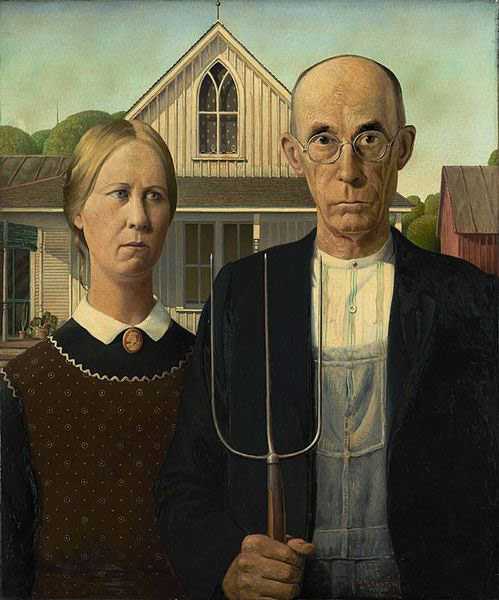 |
|
| Artist | Grant Wood |
| Year | 1930 |
| Medium | Oil on beaverboard |
| Location | Art Institute of Chicago |
| Dimensions | 29.25 in × 24.25 in |
| 74.3 cm × 62.4 cm |
American Gothic is a painting by American artist Grant Wood in 1930. Shown is a farmer and his spinster daughter in front of their house. The models on the painting were Wood’s sister, Nan, wearing a colonial print apron mimicking 19th century Americana, and Wood’s dentist, Dr. Byron McKeeby from Iowa.
Wood painted the house along with the people he imagined might live there. The house actually exists in Eldon, Iowa. It was built in the American Gothic style. The models never sat in front of the house, and each element was painted separately. The painting measures 29.25 inches by 24.5 inches, which is equivalent to 74.3 cm by 62.4 cm.
The Artist: Grant Wood
Grant Wood was born on February 13, 1892 in Iowa. After the death of his father in 1901, his family moved to Cedar Rapids where he began as an apprentice at a metal shop. He enrolled at an art school in 1910 in Minneapolis, Minnesota. In 1913, he attended the Art Institute of Chicago where he worked as a silversmith. From 1934 to 1941, he taught painting at the University of Iowa’s School of Art. A day after celebrating his 51st birthday in 1942, Wood died of liver cancer at the university’s hospital. Wood had been influenced by the works of 15th century Flemish artist Jan Van Eyck. Other famous paintings by Grant Wood include: The Little Chapel Chancelade (1926), Woman with Plants (1929) And John B. Turner, Pioneer (1929).
Painting Inspirations
Wood saw the house while travelling through the Iowa landscape in the summer of 1930, he was inspired. Some people thought that Grant Wood was making fun of small town folk. The house had an unusual window. The design is based on Gothic architecture which originates from Europe, as opposed to an American farmhouse. The contrast caught the artist’s attention that led to the painting of American Gothic.
Reception of the Painting
Wood entered American Gothic at a competition sponsored by the Art Institute of Chicago. Initially, the judges viewed it as a comic valentine. However, a patron convinced them to award it a bronze medal and a cash prize of $300. The Art Institute bought the painting where it remains to this day. Soon after, the painting began to appear in newspapers.
When the image finally appeared in the Cedar Rapids Gazette, Iowans became furious. A woman threatened to bite Wood’s ear off. However, Grant explained that his intention was not to misrepresent Iowans, but to portray America as a whole. The arrival of the Great Depression was upon the country, the painting was seen as a portrayal of the steadfast American pioneer spirit.
Artistic Features
The painting is obviously fictional in many ways. First, it has a 19th century theme painted in the 20th century. Second, the title itself refers to the architecture of the house, with the artist taking liberty to add the type of people he believed who may live there. The house’s medieval style window looks like one you may find at a church, in fact the potted plants on the porch and the decorative blind distinguishes the wooden house from a church.
Early Life
Grant Wood was born on his parents’ farm outside of Anamosa, Iowa, on February 13, 1891. These idyllic settings would leave a lasting impression on Wood and profoundly influence his later thinking and work, though he would spend much of his life after the age of 10 in the relatively more urban setting of Cedar Rapids, where his mother moved Wood and his younger sister Nan after their father died.
Wood developed his interest in art while still in grammar school and showed promise. He continued to nurture his talents in high school where he designed sets for plays and illustrated student publications. After graduation in 1910, Wood attended the Minneapolis School of Design and Handicraft. Over the next few years, Wood further expanded his creative repertoire by learning to work with metal and jewelry as well as build furniture. When he moved to Chicago in 1913, he used these skills to make a living.
Производитель: Керама Марацци
Дерево – это основной тренд в дизайне интерьеров, сохраняющий свою актуальность на протяжении многих лет. Керамическая плитка «под дерево» считается отличной альтернативой такому материалу. Она прекрасно подходит для отделки стен и пола, создавая теплую, уютную и домашнюю атмосферу. Поверхность такой керамики идеально сочетается с другими отделочными материалами любых цветов.
 Грант Вуд Автопортрет 1932 г.
Грант Вуд Автопортрет 1932 г.
Американский художник-регионалист Грант Вуд (1891-1942), известный своими картинами из жизни сельского Среднего Запада США, родился рядом с городом Анамоса в штате Айова, откуда после смерти отца в 1901 г. семья переехала в Сидар-Рапидс. Профессиональное образование Вуд получил в школе искусств в Миннеаполисе и Художественном институте в Чикаго. Между 1920 и 1928 г. он совершил четыре поездки в Европу, где изучал различные художественные стили. В его ранних работах заметно сильное влияние импрессионизма и постимпрессионизма, однако определяющим для обретения Вудом своего подлинного творческого «я» послужили художники Северного Ренессанса – прежде всего, Ян Ван Эйк и Ханс Мемлинг.
Его самая знаменитая картина «Американская готика» была написана в 1930 г. и в том же году представлена в Художественном институте Чикаго, где хранится по сей день. Это произведение немедленно принесло славу его автору, став самой узнаваемой американской картиной XX века и темой для многочисленных интерпретаций, переделок и пародий. Вдохновением для неё послужил дом в готическом стиле, попавшийся Вуду в городке Элдон в его родном штате Айова. Моделями для изображённых на фоне дома фермера и его незамужней дочери (или жены – версии расходятся) стали зубной врач художника и его сестра Нэн.
В начале тридцатых Вуд стал горячим сторонником реалистического регионализма в живописи, который пропагандировал, читая лекции в разных американских городах. Это новое почвенническое движение не могло не натолкнуться на противодействие тех художественных кругов США, представленных в основном инородцами, которые подняли на своё знамя абстракционизм и тому подобные модернистские течения. Зачастую эстетические споры принимали политическую окраску. Так, историк искусства, беженец из Германии Хорст Янсон обвинял Вуда в том, что он ставит на место всех эстетических ценностей «американизм», т.е. национализм, и заявлял: «Фактически, почти все идеи, составляющие кредо регионалистов, могут быть более или менее дословно сопоставлены с высказываниями нацистских теоретиков искусства».
Однако никакие нападки не могли помешать растущей популярности Вуда у американской публики. В годы Великой депрессии его картины, в т.ч. «Американская готика», первоначально многими воспринятая как сатира на сельскую Америку, стали восприниматься и прославляться как возвышенное выражение национального духа. Помимо создания новых полотен, Вуд продолжал заниматься образовательной деятельностью. С 1934 по 1941 г. он преподавал живопись на факультете искусств Университета штата Айова. В феврале 1942 г., в пятидесятилетнем возрасте, художник скончался в университетской больнице от рака печени.
Само собой напрашивается сравнение Гранта Вуда с другим выдающимся представителем регионализма в американской живописи – . Бросается в глаза разница в творческой манере – остаточный иконизм, унаследованный Вудом от мастеров Северного Ренессанса, придаёт его фигурам статуарность, чуждую гиперреалистической манере Уайета, которая вносит внутренний динамизм даже в самые спокойные сцены. Ну, и главное – с полотен Уайета на нас смотрит мир трагически одиноких людей, а предметом вдохновения Вуда служит глубоко оптимистическое, уверенное в себе общество.

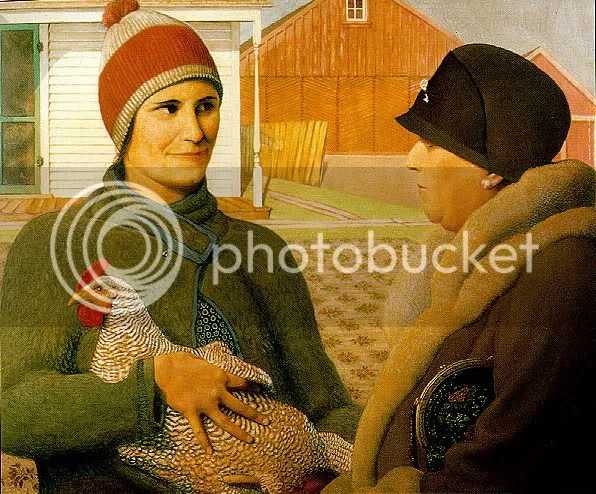


Arnold Comes of Age

A Short Break from Pasture Work

Birthplace of Herbert Hoover
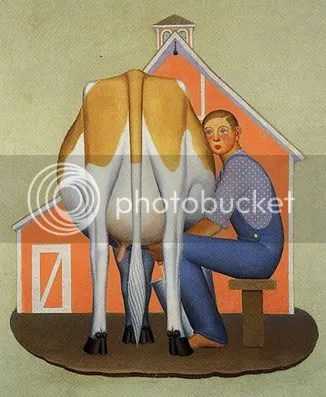
Boy Milking a Cow


Daughters of the Revolution

Death on Ridge Road


Dinner for Threshers






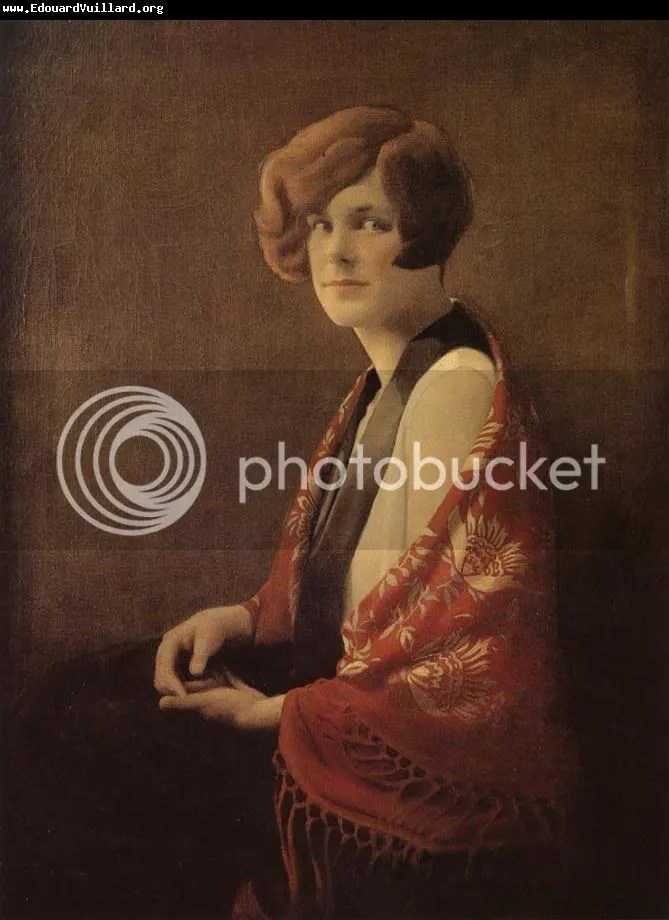

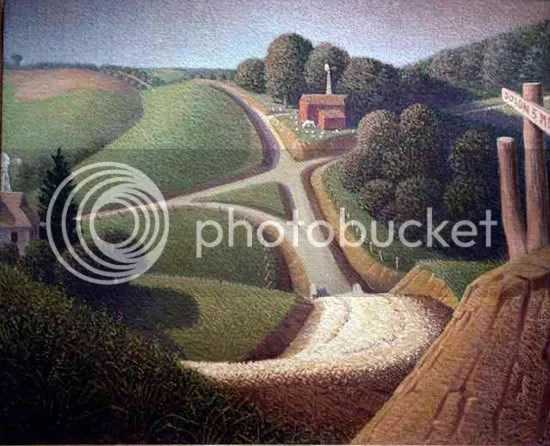


Parson Weems’ Fable

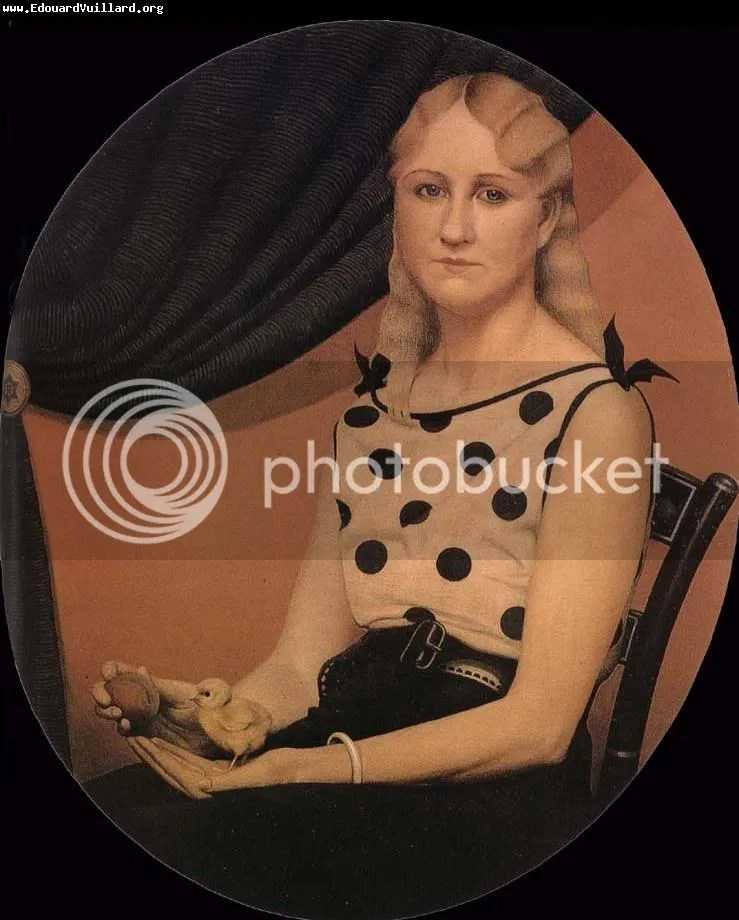
Portrait of Nan
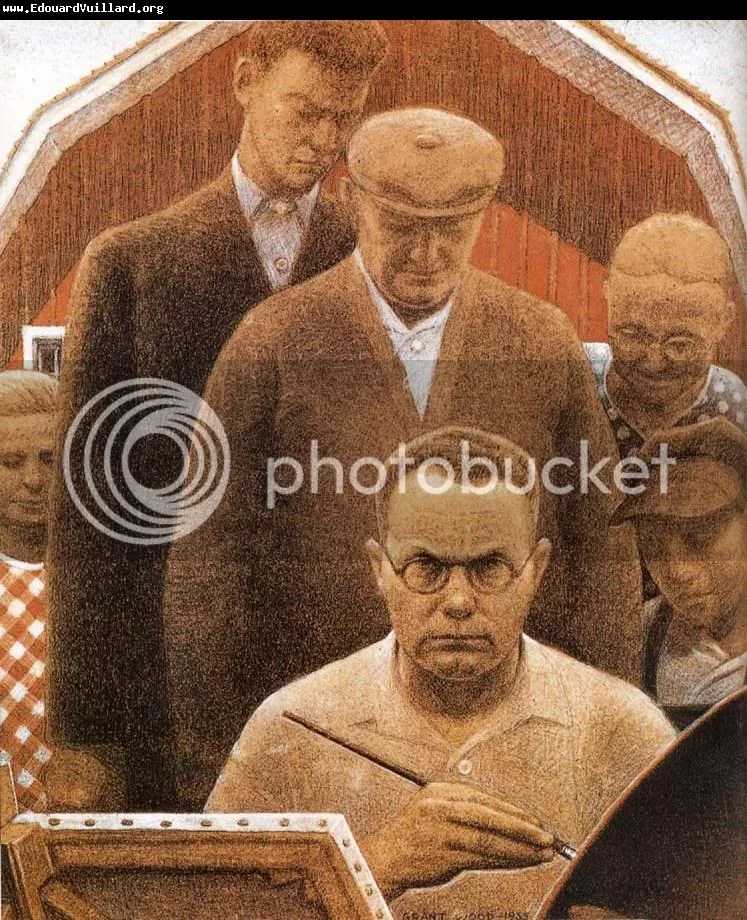
Return from Bohemia

Seedtime and Harvest


Sentimental Folk Song


Spring in the Country

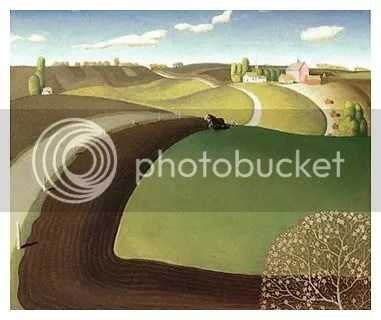



Stone City, Iowa



The Midnight Ride of Paul Revere

Portrait of John

Woman with Plants



American Gothic
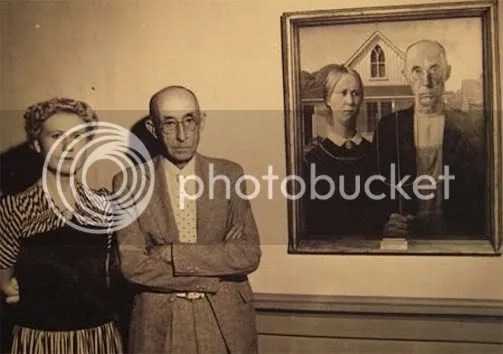
Модели «Американской готики» рядом с картиной
‘Women With Plants’ and ‘Revolt Against the City’
With his paintings of small-town life, Midwestern landscapes and historical scenes, Wood became the de facto spokesperson for the American Regionalist movement. His paintings were much in demand. Besides American Gothic, other representative works include Woman With Plants (1929), The Appraisal (1931) and Daughters of Revolution (1932).
In 1932, Wood used his newly won fame to co-found the Stone City Colony and Art School, where he could spread the message of Regionalism to aspiring artists. Two years later, however, he accepted a position with the art department at the University of Iowa, where he believed he could have an even greater impact. That same year, Wood was also named director of the Public Works of Art Project in Iowa and was featured in a Time magazine cover story about Regionalism. In 1935, he published the essay “Revolt Against the City,” in which he laid out the tenets of the movement.
Difficult Times and Death
Despite these successes, Wood was about to enter the most trying period in his life. In 1935, he rather suddenly married a woman named Sara Maxon, with whom he would maintain a difficult relationship for the next few years in part because of his latent homosexuality. Wood and Maxon ultimately divorced in 1939, at a time when he was also in trouble with the IRS for tax evasion.
Meanwhile, Wood’s professional world was coming apart as well. With the rise of abstract movements in American art, Wood’s Regionalism was falling out of favor and put him at odds with many of the faculty at the university. Frustrated, in 1940, Wood took a leave of absence.
Throughout this trying time, however, Wood had continued to work. Paintings such as Death on Ridge Road (1935), Parson Weems’ Fable (1939) and Iowa Cornfield (1941) all show his faithful adherence to the American art movement he was primarily responsible for founding. He died of cancer on February 12, 1942, at age 50, and was buried on his family’s plot in Anamosa.
QUICK FACTS
- Name: Grant Wood
- Birth Year: 1891
- Birth date: February 13, 1891
- Birth State: Iowa
- Birth City: Anamosa
- Birth Country: United States
- Gender: Male
- Best Known For: Grant Wood was an American painter who is best known for the iconic work ‘American Gothic.’
- Industries
Art
- Astrological Sign: Aquarius
- Schools
- Académie Julian, Paris
- Art Institute of Chicago
- Minneapolis School Of Design And Handicraft
- Death Year: 1942
- Death date: February 12, 1942
- Death State: Iowa
- Death City: Iowa City
- Death Country: United States
CITATION INFORMATION
- Article Title: Grant Wood Biography
- Author: Biography.com Editors
- Website Name: The Biography.com website
- Url: https://www.biography.com/artists/grant-wood
- Access Date:
- Publisher: A&E; Television Networks
- Last Updated: March 29, 2021
- Original Published Date: April 2, 2014
Working Artist
In Chicago, Wood spent his days at his jewelry and metalworking shop and his evenings developing his talents through correspondence courses and classes at the Art Institute. However, when his mother fell ill in 1916, Wood left Chicago to return to Cedar Rapids, where he took a job as a grammar school teacher to support his mother and sister. However, his familial obligations did not stop Wood from continuing to make progress as an artist. As such, several years later a local department store held an exhibition that included several of his paintings and led to further commissions.
During the 1920s, Wood was also able to find a way to travel to Europe, visiting the museums of France and Italy, studying at the Académie Julian and exhibiting his work in Paris. He returned from these trips profoundly inspired by the Impressionists, whose pastoral subject matter spoke to his own sensibilities.





















